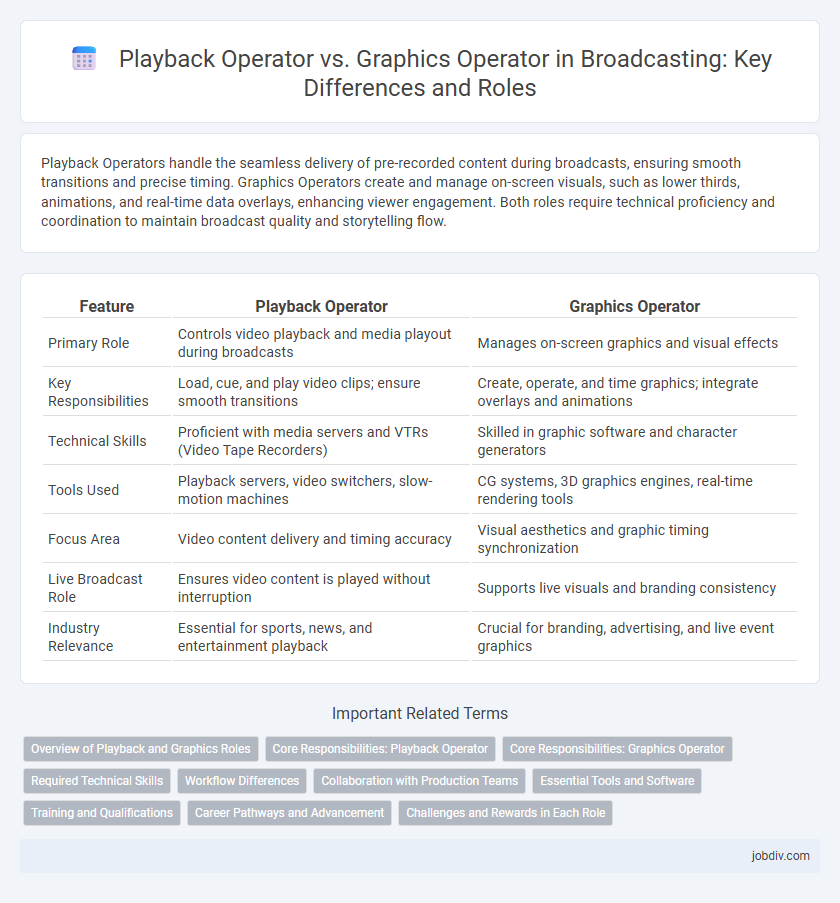Playback Operators handle the seamless delivery of pre-recorded content during broadcasts, ensuring smooth transitions and precise timing. Graphics Operators create and manage on-screen visuals, such as lower thirds, animations, and real-time data overlays, enhancing viewer engagement. Both roles require technical proficiency and coordination to maintain broadcast quality and storytelling flow.
Table of Comparison
| Feature | Playback Operator | Graphics Operator |
|---|---|---|
| Primary Role | Controls video playback and media playout during broadcasts | Manages on-screen graphics and visual effects |
| Key Responsibilities | Load, cue, and play video clips; ensure smooth transitions | Create, operate, and time graphics; integrate overlays and animations |
| Technical Skills | Proficient with media servers and VTRs (Video Tape Recorders) | Skilled in graphic software and character generators |
| Tools Used | Playback servers, video switchers, slow-motion machines | CG systems, 3D graphics engines, real-time rendering tools |
| Focus Area | Video content delivery and timing accuracy | Visual aesthetics and graphic timing synchronization |
| Live Broadcast Role | Ensures video content is played without interruption | Supports live visuals and branding consistency |
| Industry Relevance | Essential for sports, news, and entertainment playback | Crucial for branding, advertising, and live event graphics |
Overview of Playback and Graphics Roles
Playback Operators manage the seamless sequencing and timing of video, audio, and multimedia content during live broadcasts, ensuring smooth transitions and cue execution. Graphics Operators specialize in the creation, integration, and real-time rendering of visual elements such as titles, lower thirds, and animations to enhance broadcast storytelling. Both roles require precision and coordination to maintain broadcast quality and viewer engagement.
Core Responsibilities: Playback Operator
Playback Operators manage the timely and precise airing of video content during live broadcasts, ensuring seamless transitions and adherence to broadcast schedules. Their core responsibilities include cueing media files, operating playback equipment, and monitoring signal quality to prevent disruptions. Accurate execution and real-time troubleshooting are essential to maintain broadcast integrity and viewer experience.
Core Responsibilities: Graphics Operator
Graphics Operators specialize in managing visual content, including creating, scheduling, and executing on-air graphics such as lower thirds, titles, and animations to enhance broadcast quality. They ensure synchronization of graphics with live or pre-recorded video feeds, maintaining clarity and timing to support viewer comprehension. Their role requires proficiency in graphic software and real-time troubleshooting to seamlessly integrate visual elements within the broadcast workflow.
Required Technical Skills
Playback Operators must master broadcast automation systems such as EVS and Clips, ensuring seamless video cueing and real-time content playback during live productions. Graphics Operators require expertise in software like Vizrt or ChyronHego, enabling them to create and manipulate dynamic on-screen graphics and overlays with precision. Both roles demand strong synchronization skills, but Playback Operators focus on video technicalities while Graphics Operators emphasize visual design integration.
Workflow Differences
Playback Operators manage the seamless integration and timing of video content during live broadcasts, ensuring precise control over media playback and transitions. Graphics Operators focus on the real-time creation and manipulation of on-screen visuals, including animations, overlays, and data-driven graphics to enhance viewer engagement. Workflow differences hinge on Playback Operators handling linear media sequencing and timing, while Graphics Operators coordinate dynamic graphic content synchronized with broadcast events.
Collaboration with Production Teams
Playback Operators and Graphics Operators collaborate closely with production teams to ensure seamless content delivery and visual storytelling. Playback Operators manage video content cues and timing, synchronizing feeds with live broadcasts, while Graphics Operators create and synchronize on-screen graphics that enhance viewer engagement. Their coordinated efforts optimize broadcast flow, maintain visual consistency, and support narratives throughout live and recorded productions.
Essential Tools and Software
Playback Operators rely heavily on media servers like EVS XTAccess or Avid Maestro to manage and cue video content efficiently during live broadcasts. Graphics Operators utilize software such as Vizrt, ChyronHego, or Ross XPression to create and control real-time on-screen graphics, including lower thirds, scoreboards, and animations. Both roles require precise synchronization and integration with broadcast automation systems, ensuring seamless visual presentation and content delivery.
Training and Qualifications
Playback Operators typically require training in video editing software, signal flow understanding, and live broadcast techniques to ensure seamless content delivery during transmissions. Graphics Operators need specialized training in graphic design tools, animation software, and real-time graphics rendering to enhance broadcast visuals effectively. Both roles benefit from industry certifications and hands-on experience in a live broadcast environment to meet quality and timing standards.
Career Pathways and Advancement
Playback Operators specialize in cueing and controlling video segments during live broadcasts, often progressing to roles like Broadcast Technician or Technical Director by gaining experience in signal flow and equipment operation. Graphics Operators focus on creating and managing on-screen visuals, with career advancement leading to positions such as Senior Graphics Designer or Broadcast Graphics Manager through expertise in animation software and visual storytelling. Both pathways benefit from technical proficiency and adaptability, offering opportunities to advance into supervisory or cross-departmental roles within the broadcast production environment.
Challenges and Rewards in Each Role
Playback Operators face the challenge of ensuring seamless video and audio content delivery during live broadcasts, requiring precise timing and quick troubleshooting skills; their reward lies in maintaining broadcast continuity and viewer satisfaction. Graphics Operators manage real-time on-screen visuals, handling complex software and coordinating with production teams to enhance storytelling, with the reward of creating visually engaging content that elevates the broadcast experience. Both roles demand technical expertise and adaptability, contributing critically to the overall quality and professionalism of a live broadcast.
Playback Operator vs Graphics Operator Infographic

 jobdiv.com
jobdiv.com